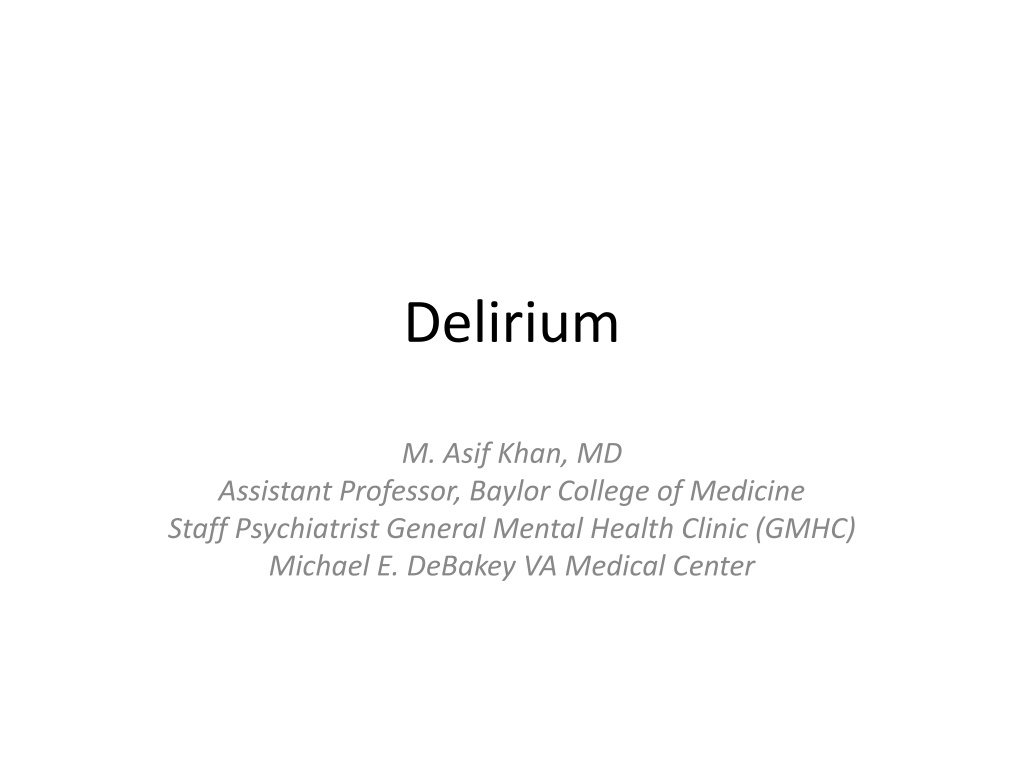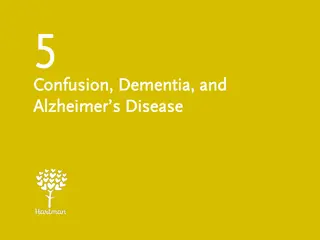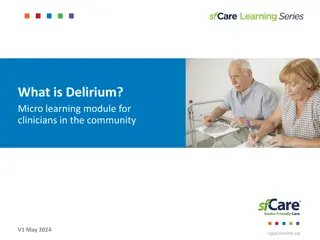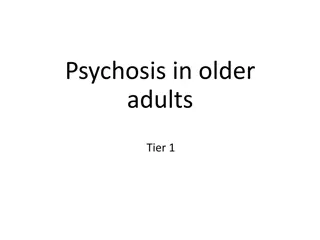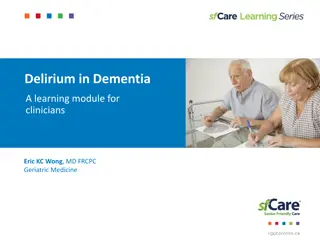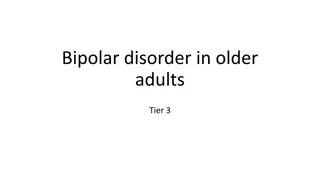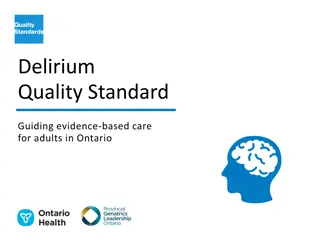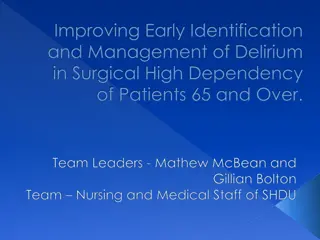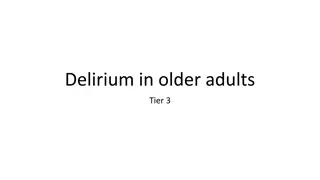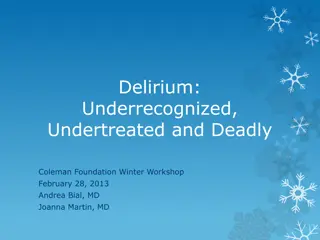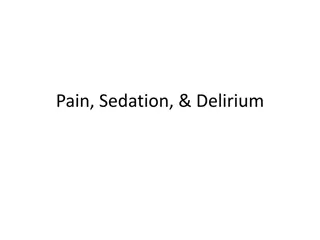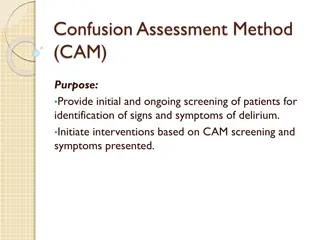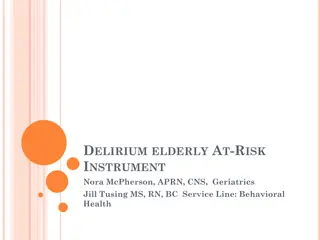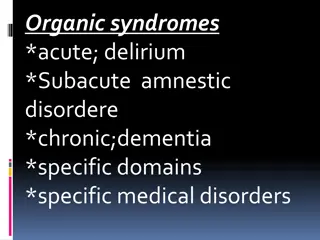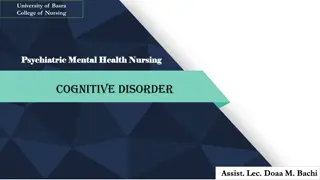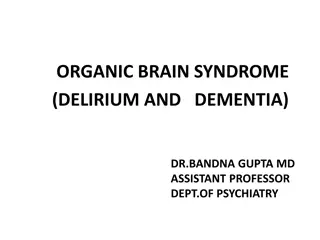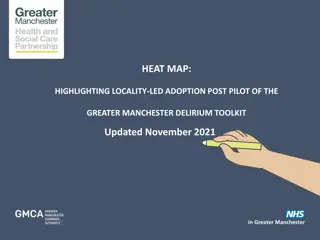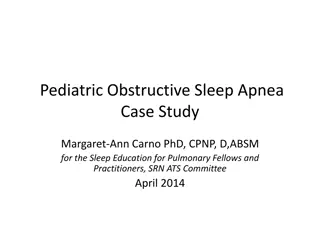Understanding Delirium: Diagnosis, Management, and Implications
Delirium, a common yet often misdiagnosed condition, is a disturbance of consciousness with acute onset and fluctuating symptoms. Learn about its impact, diagnostic criteria, and management strategies in clinical settings to improve patient outcomes.
Uploaded on Sep 28, 2024 | 0 Views
Download Presentation

Please find below an Image/Link to download the presentation.
The content on the website is provided AS IS for your information and personal use only. It may not be sold, licensed, or shared on other websites without obtaining consent from the author. Download presentation by click this link. If you encounter any issues during the download, it is possible that the publisher has removed the file from their server.
E N D
Presentation Transcript
Delirium M. Asif Khan, MD Assistant Professor, Baylor College of Medicine Staff Psychiatrist General Mental Health Clinic (GMHC) Michael E. DeBakey VA Medical Center
Objectives Overview of Delirium: Understand the pathology of delirium and how to diagnose and identify delirium in a clinical setting. Managing Agitation in Delirium: Pharmacological and non pharmacological management of delirium Caveats of Medication Management:
Delirium Very Common reason for Consultation Liaison Psychiatry Consult in the hospital setting and very often misdiagnosed as depression, anxiety and advancing dementia. Major cause of prolonged hospital stay. Preventable in many cases 11% mortality rate Delirium occurs in: 10-15 % of all hospitalized adults 30-50% of all geriatric admissions 80% of ICU patients has some form of Delirium.
Delirium Delirium is often described as: 1. An acute confused state 2. Septic Encephalopathy 3. Acute Brain Failure 4. ICU Psychosis
Delirium Defined Delirium is a disturbance of consciousness characterized by acute onset and fluctuating course of inattention accompanied by either a change in cognition or a perceptual disturbance, so that a patient s ability to receive, process, store, and recall information is impaired.
DSM 5 Criteria for Delirium A. Disturbance in attention (i.e., reduced ability to direct, focus, sustain, and shift attention) and awareness (reduced orientation to the environment). Patient will be able to see and acknowledge you however they will not be able to sustain the attention
DSM 5 B. The disturbance develops over a short period of time (usually hours to a few days), represents an acute change from baseline attention and awareness, and tends to fluctuate in severity during the course of a day. Patient will have an abrupt change in cognition from baseline and symptoms will be fluctuating. Patient will go in and out of a state of confusion. Sundowning.
DSM 5 C. An additional disturbance in cognition (e.g. memory deficit, disorientation, language, visuospatial ability, or perception). Patient has difficulty with attention and is accompanied by an additional disturbance in cognition. Very Low Mini Mental Score
DSM 5 D. The disturbances in Criteria A and C are not better explained by a pre-existing, established or evolving neurocognitive disorder and do not occur in the context of a severely reduced level of arousal such as coma. Not a progression of a pre-existing dementia (dementia predisposes) , remember acute. Patient has to be able to respond to verbal stimulation.
DSM 5 E. There is evidence from the history, physical examination or laboratory findings that the disturbance is a direct physiological consequence of another medical condition, substance intoxication or withdrawal (i.e. due to a drug of abuse or to a medication), or exposure to a toxin, or is due to multiple etiologies. There is always a medical reason for delirium, trick is to find it.
DSM 5 Specifiers (1)substance intoxication delirium (2)substance withdrawal delirium (3)medication-induced delirium (4)delirium due to another medical condition (5)delirium due to multiple etiologies (6)acute (7)persistent (8) Hyperactive: Agitation (9) Hypoactive: quiet, compliant or depressed (10) mixed level of activity
Predisposing Factors Older age Cognitive Deficits Sensory: Hearing, Vision, Dentures Medical Comorbidities Polypharmacy
Anticholinergic Meds ANTIHISTAMINES (H-1 BLOCKERS) chlorpheniramine cyproheptadine diphenhydramine hydroxyzine GASTROINTESTINAL 1. cimetidine 2. ranitidine 3. chlordiazepoxide 4. dicyclomine 1. 2. 3. 4. 1. 2. 3. 4. CARDIOVASCULAR furosemide digoxin nifedipine disopyramide URINARY INCONTINENCE 1. oxybutynin 2. probantheline 3. solifenacin 4. trospium PSYCHIATRIC 1. quetiapine 2. paroxetine
Pathophysiology Pathogenesis of Delirium is not fully understood, most likely due to the accumulation of several factors. The straw that broke the camel s back? Neurotransmitter: Increase in Dopamine and decrease in Acetylcholine Encephalopathy and Inflammation : Increase in cytokines IL-8, TNF, Cortisol Disturbance in the sleep wake cycle: GABA Decrease in oxygenation to the brain
Precipitating Factors and Iatrogenic D: Drugs and Dementia E: Eyes, Ears and other sensory deficits L: Low O2 states I: Infection R: Retention (Bowel and Bladder) I: Ictal state U: Under Hydration and Nutrition M: Metabolic Causes S: Sleep and Subdural
Diagnosis Delirium is a Clinical Diagnosis Difficult to obtain from EEG or Imaging. Collateral information from patients family, nursing home, nursing staff about acute change in mental status from baseline. Many tools and rating scales to chose from CAM-ICU: Confusion Assessment Method for the ICU. Very high sensitivity and specificity.
CAM-ICU If CAM-ICU is positive and delirium established then look at RASS again. Hyperactive Delirium: RASS +1 to +4 Hypoactive Delirium: RASS -1 to -3, useful to distinguish from depression. Delirium can start as hypoactive and progress to hyperactive, be mixed type, and can vacillate between hypo and hyper active form.
Question Which of the following psychotropic medication(s) has the following Black Box warning? Not approved for dementia-related psychosis; increase mortality risk in elderly dementia patients most deaths due to cardiovascular or infectious events.
Question A) Risperidone B) Clozapine C) Olanzapine D) Haloperidol E) All of the above F) None of the Above G) B and C
Answer E) All of the above All antipsychotic medications have the Black Box warning of increased death when used in elderly patients with psychosis. This includes first, second, and third generation medications.
Treating Delirium Antipsychotic medications are the mainstays of treating Delirium Very important to document that the benefit of the treatment outweighs the risk of non- treatment. Start low and titrate up as needed.
Treating Delirium 1. Start low dose antipsychotic medication and titrate up as needed. Haloperidol is the most commonly used medication to treat delirium and is considered the gold standard. Second generation antipsychotic medications such as risperidone, olanzapine, quetiapine can also be used, considered second line agents. Always try to use oral medications before going to IM and IV dosing.
Treating Delirium Hypoactive Delirium: RASS -1 to -3 Patient with hypoactive delirium present with sedation and appear lethargic. They respond questions slowly and have decrease spontaneous movement, very often confused with depression. 1. Treating and reversing underlying cause 2. Haloperidol 5mg PO or 0.5-1mg IM or IV BID 3. Risperidone 1mg PO or 0.5- 1mg IM or IV BID
Treating Delirium Hyperactive Delirium: RASS +2 to +4 Patient with hyperactive delirium present with agitation, restlessness, combative and often exhibit psychotic symptoms of hallucinations and delusions. Patients are often a danger to self and others.
Treating Delirium 1. Initial Haloperidol dose; 10mg PO or 5mg IM or IV and reassess in 45-60 minutes. If the patient continues to be agitated the next dose should be 10mg PO or double the IM/IV the dose 10mg and reassess in 45-60min. If the patient continues to be agitated then continue giving the dose of 10mg either PO, IM/IV every hour until the agitation is controlled. 2. When the agitation is controlled add up the total doses of haloperidol given. Take that number and divide by two, that amount is the standing dose of haloperidol given BID. 3. Continue to use the standing dose until the delirium clears up and the patient is back to baseline.
Caveats of using Medication Haloperidol has the risk of increasing the QTc interval on an EKG, IV >>IM>>PO, QTc should be under 500 to be safe. Prolonged QTc interval increases the chance of developing Torsade de Pointes which is a fatal arrhythmia.
Torsade de Pointes DOCUMENT that the benefit of the treatment outweighs the risk of non-treatment, that all other non restrictive and non evasive options were exhausted. 1:1 Monitoring Continuous EKG monitoring especially in ICU setting Electrolytes: Keep Magnesium and Potassium at upper levels of normal to protect against Torsade de Pointes from forming. Torsade de Pointes is very rare, however it is fatal if untreated and requires cardioversion
Dystonia Dystonia: involuntary movement disorder in which a person's muscles contract uncontrollably in a twisting manner. Haloperidol usually affects the neck muscles.
Dystonia Patients with high muscle mass and low body fat are more prone to develop dystonia with haloperidol. Mesomorph > Ectomorph > Endomorph.
Dystonia Dystonia is not an allergy to a medication, it is an idiopathic response. Treatment of Dystonia is with anticholinergic medications such as benztropine. Despite being an anticholinergic medication is indicated when a patient has dystonia or is high risk for developing dystonia. Benztropine dose for dystonia is 1-2mg PO or IM BID. Patients with Mesomorphic body type should be given benztropine along with haloperidol.
Benzodiazepines Benzodiazepines are not recommended for the treatment of agitation or delirium in elderly patients. Benzodiazepines have the potential to cause more agitation due to dis-inhibitory effects of the medication.
